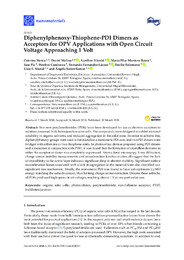Please use this identifier to cite or link to this item:
https://hdl.handle.net/11000/4803Full metadata record
| DC Field | Value | Language |
|---|---|---|
| dc.contributor.author | Stenta, Caterina, | - |
| dc.contributor.author | Molina, Desiré | - |
| dc.contributor.author | Viterisi, Aurélien | - |
| dc.contributor.author | Montero Rama, María Pilar | - |
| dc.contributor.author | Pla, Sara | - |
| dc.contributor.author | Cambarau, Werther, | - |
| dc.contributor.author | Fernández Lázaro, Fernando | - |
| dc.contributor.author | Palomares, Emilio | - |
| dc.contributor.author | Marsal, Lluis F. | - |
| dc.contributor.author | Sastre Santos, Ángela | - |
| dc.contributor.other | Departamentos de la UMH::Farmacología, Pediatría y Química Orgánica | es |
| dc.date.accessioned | 2018-07-27T12:52:25Z | - |
| dc.date.available | 2018-07-27T12:52:25Z | - |
| dc.date.created | 2018-03-26 | - |
| dc.date.issued | 2018-07-27 | - |
| dc.identifier.issn | 1463-9076 | - |
| dc.identifier.issn | 1463-9084 | - |
| dc.identifier.uri | http://hdl.handle.net/11000/4803 | - |
| dc.description.abstract | Two new perylenediimides (PDIs) have been developed for use as electron acceptors in solution-processed bulk heterojunction solar cells. The compounds were designed to exhibit maximal solubility in organic solvents, and reduced aggregation in the solid state. In order to achieve this, diphenylphenoxy groups were used to functionalize a monomeric PDI core, and two PDI dimers were bridged with either one or two thiophene units. In photovoltaic devices prepared using PDI dimers and a monomer in conjunction with PTB7, it was found that the formation of crystalline domains in either the acceptor or donor was completely suppressed. Atomic force microscopy, X-ray diffraction, charge carrier mobility measurements and recombination kinetics studies all suggest that the lack of crystallinity in the active layer induces a significant drop in electron mobility. Significant surface recombination losses associated with a lack of segregation in the material were also identified as a significant loss mechanism. Finally, the monomeric PDI was found to have sub-optimum LUMO energy matching the cathode contact, thus limiting charge carrier extraction. Despite these setbacks, all PDIs produced high open circuit voltages, reaching almost 1 V in one particular case | en |
| dc.description.sponsorship | This work was supported by the Spanish Ministry of Economy, Industry and Competitiveness (MEIC) (TEC2015-71324-R, CTQ2014-55798-R and TEC2015-71915-REDT (MINECO/FEDER)) | en |
| dc.description.sponsorship | This work was supported by the Catalan Institution for Research and Advanced Studies (ICREA) (ICREA “Academia Award”, AGAUR 2017 SGR 017SGR1527) | en |
| dc.format | application/pdf | es |
| dc.format.extent | 12 | es |
| dc.language.iso | eng | en |
| dc.rights | info:eu-repo/semantics/openAccess | en |
| dc.subject | organic solar cells | en |
| dc.subject | photovoltaics | en |
| dc.subject | perylenediimide | en |
| dc.subject | non-fullerene acceptor | en |
| dc.subject | PTB7 | es |
| dc.subject | bulkheterojunction | en |
| dc.subject.other | 547 - Química orgánica | es |
| dc.title | Diphenylphenoxy-Thiophene-PDI Dimers as Acceptors for OPV Applications with Open Circuit Voltage Approaching 1 Volt | en |
| dc.type | info:eu-repo/semantics/article | en |
| dc.identifier.doi | 10.3390/nano8040211 | - |
| dc.relation.publisherversion | https://doi.org/10.3390/nano8040211 | - |

View/Open:
2-2018 nanomaterials 211.pdf
16,21 MB
Adobe PDF
Share:
.png)
